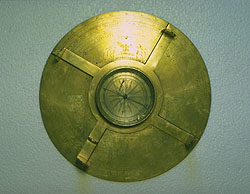 79. Circumferentor by F. Merighius
79. Circumferentor by F. Merighius
This example of an azimuth plate - which bears the inscription Franciscus mire expressit Merighius aere and a coat-of-arms with three heads of negroes over fleurs-de-lis - consists of a circle fitted with two sighting alidades, one at right angles to the other, with a compass in the middle. The compass was there only to orient the instrument and had nothing to do with measuring the degrees which was done with the graduated alidade. Each of the quadrants of the circle is divided into degrees and the year is divided into months and days. Also marked are the entrances of the Sun in the zodiac signs, the direction of the eight main winds, the names of which are written in Italian, and the names of the months and the zodiac constellations in Latin.
In his treatise on the square, Muzio Oddi (1569-1639), engineer to the Duke of Urbino, criticizes this instrument as "the most fallacious and least trustworthy of all the instruments used by Architects", both as regards the production difficulties and "the magnetized iron gadget, so difficult to find in perfected form, and the many things which impinge on the stone (magnetite) properties".
Instruments like this, used only for measuring horizontal angles - and hence mainly for surveying fortifications - were rendered obsolete by the development of the altazimuth theodolite - able to measure heights too - ushered by the work of the German Martin Waldseemüller and the Englishman Leonard Digges .
J.A. Bennett (1987), pp. 41-71.
L. Digges (1571).
F. Farinelli (1979), p. 191.
M. Holbrook (1992), pp. 35 and 74.
G. L’E. Turner (1991), p. 198.